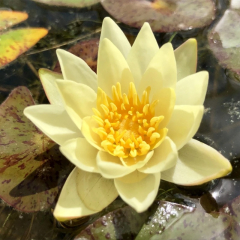Cookie Policy
We use cookies to help improve the experience you have on this site. You can find out more here.

Although many animals will visit a variety of water features, a well-designed wildlife pond will attract a wide range of native creatures and enable them to thrive and reproduce, to the benefit of both garden and gardener. Frogs and toads will help control slugs and snails, dragonflies have a hearty appetite for mosquitoes and other flying-insects and garden birds will benefit from somewhere to drink and bathe. Indeed, choosing to add a water feature to your garden will open your eyes to another world. Unlike satisfying the demands of fish, wildlife ponds don’t need to be particularly deep or filtered to function. Setting up a wildlife pond can be both budget and eco-friendly and monitoring the species that colonise it adds another dimension to your enjoyment of the garden.
First dig your hole – the good news is that most aquatic life enjoys the shallows and there’s no need to dig too deep. This makes liners economical as well as flexible, especially if you incorporate bog sections to benefit amphibians. An underlay protects the liner from puncture and can be used both below and above to enable the addition of soil or gravel to the base of the pond, whilst giving traction to a range of paws and claws.
As an off the peg option, preformed pools give instant design and structure with scope to install them above ground in areas where steep slopes or high water-tables might complicate the use of a liner. Planting shelves can be filled with potted marginal plants or gently added rockwork to ease the transition between water and land, as well as providing easier access for creatures unable to tackle the smooth sides. Deeper ponds suit species such as toads and great crested newts, which naturally favour large water bodies and are better able to breed alongside fish.
Adding water movement to your pond can help to keep things fresh and avoids the low oxygen levels caused by oxygenating plants at night. Moving water attracts a range of species not seen in still environments and seems especially attractive to garden birds. Solar technology gives freedom from hard-wired installation, while mains powered pumps can be relied on to keep drinking water free of ice in the short, dark days when it’s needed most.
Pond plants are the heart of any aquatic ecosystem and bring beauty as well as biological function. Not only do plants provide cover for wildlife, nectar for pollinators and competition for algae – some of the most striking are natives which add greatly to the visual appeal of what’s otherwise a water-filled hole in the ground

Wildlife ponds tend to look after themselves but sometimes a little steering is needed to restore balance. Algae and duckweed can thrive at the expense of other life and may need remedial action to control, it’s also good to have tap water conditioner on hand for those emergency top-ups when the water butt runs dry.
Lighting can transform any feature into something magical. As well as adding designer flair it enables some of the more nervous nocturnal visitors to be observed without undue disturbance as well as providing hunting bats and toads with extra foraging opportunities.
For delivery before Christmas, orders must be placed on or before 3pm on Wednesday 20th December. We cannot guarantee delivery of these orders pre-Christmas as we are reliant on our couriers, but will use our best endeavours to get orders placed on this date out to you before Christmas. For full details of our festive delivery and opening times click here
Please note: online orders placed after 3pm on Friday 22nd December will not be dispatched until the New Year. For full details of our festive delivery and opening times click here